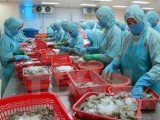Embattled Vietnam agriculture loses market share on home turf
Vietnamese agriculture, battling to retain confidence among consumers, is losing market share across the agriculture and food spectrum, once considered its unbreakable home turf.
embattled vietnam agriculture loses market share on home turf hinh 0 As protectionist barriers crumble as a result of the country tossing aside bilateral trade in favour of free trade agreements, foreign multinational companies are rushing in to find new opportunities for growth.
Their arrival is a boon to local consumers, who benefit from the wider choices now available.
For local companies, however, the influx appears to be a death sentence says Nguyen Hoai Nam, deputy general secretary of the Vietnam Association of Seafood Exporters and Producers.
Seafood farmers and producers, who are accustomed to dominant positions in the formerly protected market, suddenly find themselves waking up each day to face foreign competitors wielding a daunting array of advantages.
The free trade region created by the ASEAN Economic Community has resulted in foreign multinationals streaming across the border and taking over as a result of their substantial financial resources, advanced technology, superior products, powerful brands, and seasoned marketing and management skills.
The very survival of local seafood companies across the country is at stake, Mr Nam complains.
The situation has left, Mr Nam and many others just like him, calling on the government to reinstate trade barriers or provide some other form of support, which is tantamount to admitting they have no business savvy.
Some multinationals, such as Big C, don’t even want local seafood products on their shelves, Mr Nam says in disgust, noting that at one time they asked for discounts of up to 25% or told them to take their products elsewhere.
Still others in the seafood segment have simply sold out and left the business, Mr Nam moans.
The reason is twofold. The Thai owners of Big C have ready access to fish and seafood products from their home country and local consumers have more confidence in the food safety of Thai products than they do in those from Vietnam.
Fortunately for Vietnam, there are many like economist Vo Tri Thanh who believe there are other options for agriculture like those in the seafood segment who are facing stiff competition.
Mr Than, who has studied the successful strategies and tactics of other countries that faced similar situations to what Vietnam is now up against, understands fully that the situation is not dire and other country’s advantages are not as formidable as they may at first appear.
The answer, says Mr Than, is for agriculture to stay independent of the foreign multinationals and fortify their existing competitive assets. Local agriculture needs to beef up distribution and invest more in research and development to retake the home turf.
The segment as a whole must develop a comprehensive plan to restore consumer confidence in the food safety of its products and strictly comply with VietGap standards to ensure clean, safe products are consistently supplied to the local market.
Just as importantly, Mr Than asserts, the agriculture segment must globalize and develop its own strategy to do so. By developing a better understanding of how the country’s competitive advantages stack up against the international market they can better assess the actual strengths of their multinational rivals.
Agriculture, including fish and seafood, is an industry for which success turns first and foremost on meeting the particular demands of local consumers— and Vietnam agriculture must learn how to establish relationships with their customers.
Foreign multinationals can’t compete in the Vietnamese market simply by selling standardized products at a lower cost. High transportation costs alone discourage a global presence.
The fundamental problem is that for far too long the agriculture segment in Vietnam has ignored the demands of consumers and it now will take a lot of hard work and effort on its part to gain their confidence and respect.
Vu Tien Loc, president of the Vietnam Chamber of Commerce and Industry, suggests it could take as much as 10-20 years for agriculture to turn itself around and adapt to a competitive environment.
VOV
- HCM City moves towards Net Zero (19/04)
- Further setting up project on entrusting loans to officials, civil servants and public employees for buying social housing apartments (19/04)
- Firm steps of reforms (19/04)
- To test try consensus of moving enterprises north, Binh Duong province (19/04)
- Provincial enterprises are ready to join the global supply chain (19/04)
- Exhibition aims to foster cooperation in smart urban development (18/04)
- Strengthening support for German enterprises to invest in Binh Duong (17/04)
- Thuan An City adjusts orchards combined with eco-tourism along the Saigon River (17/04)
 Firm steps of reforms
Firm steps of reforms
 Provincial enterprises are ready to join the global supply chain
Provincial enterprises are ready to join the global supply chain
 Infrastructure planning to develop modern ecosystem of modern logistics
Infrastructure planning to develop modern ecosystem of modern logistics
 Deputy Prime Minister Tran Hong Ha: Binh Duong will open a new era of green, sustainable energy development
Deputy Prime Minister Tran Hong Ha: Binh Duong will open a new era of green, sustainable energy development
 Green transformation for sustainable development
Green transformation for sustainable development
 Horasis China Meeting 2024 in Binh Duong: Opportunity for investment cooperation, promoting sustainable development
Horasis China Meeting 2024 in Binh Duong: Opportunity for investment cooperation, promoting sustainable development
 Sustainable economic development includes application of technologies, sectional planning, and environment assurance
Sustainable economic development includes application of technologies, sectional planning, and environment assurance
 Commodity origin faking, alarming
Commodity origin faking, alarming
 Tokyu Group visits and expands investment in high-tech sectors in Binh Duong
Tokyu Group visits and expands investment in high-tech sectors in Binh Duong
 Project on testing technologies and cooperation of green transformation
Project on testing technologies and cooperation of green transformation








